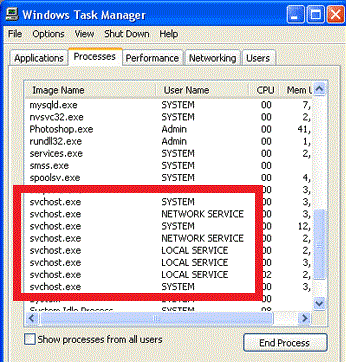

- Svchost exe network service update#
- Svchost exe network service full#
- Svchost exe network service windows#
If you think this might be the case, then you can try uninstalling the latest update you made to your computer to see if that fixes the issue.
Svchost exe network service windows#
In some cases, high network resource usage can be caused by a problem with a Windows update. Windows Update is Causing High Network Usage. If a service is configured to start automatically but doesn’t need to be running all the time, it may result in high resource usage. The services you see running in the Task Manager are often configured to either start automatically on computer bootup or start manually as needed. There’s An Issue With System Configuration.Īnother common reason for svchost high network usage is because you have a misconfigured service. This can cause high resource usage, and in some cases, even result in a complete loss of internet connectivity. If your network adapter is out of date or is old, then it might not be able to handle the amount of traffic it is receiving.
Svchost exe network service full#
If you think you might be infected with a virus or malware, then you should run a full scan of your computer with an antivirus program. These malicious programs can cause your computer to slow down, and in some cases, can even disable your antivirus software. One of the most common reasons for high resource usage is that your computer is infected with a virus or malware. Now that we know what svchost.exe high network usage looks like, let’s talk about some of the common reasons why the Service Host Network Service might be using up a huge chunk of your computer’s resources. 4 Reasons Why The SVCHOST Has High Network Usage

In some cases, you may not even be able to open up the Task Manager to check on the Service Host Network Service. With these numbers, you can expect your computer to have slow performance, decreased internet speed, connectivity problems, freezing, lagging, and even crashing. If you’re seeing the Service Host Network Service using up a lot of your bandwidth, then this is likely the cause of your slow internet. In general, if the Service Host Network Service is taking up more than 50% of your CPU usage, this is considered high, while 80% or greater is considered very high.Īs for Service Host Network Service’s high network usage, anything above 0.1 Mbps is considered high, and anything above 0.5 Mbps is considered very high. Now that we know a bit more about the Service Host Network Service, let’s talk about what counts as high resource usage. SVCHOST Resource Hogging: How High is Too High? We have written dedicated articles for these two, which you can access from the links provided. Other common suspects include Service Host Sysmain, otherwise known as Superfetch, and Service Host: Local System, which can also be a notorious CPU or disk hog. However, there are other culprits when it comes to talking up too much of your computer’s resources than the Service Host Network Service. We will cover the most common reasons for resource hogging in one of the sections below. In most cases, the high resource usage is caused by a misconfigured service or a problem with a Windows update. While the Service Host Network Service is an essential part of Windows, it can sometimes consume a lot of resources, resulting in slow performance and network issues. It acts as a “host” for all of these other services and facilitates communication between them. This is where the Service Host Network Service comes in. The Windows operating system needs all the Service Host processes to run correctly, and communicate with one another. When scrolling through your Task Manager, you’ll see a ton of Service Hostnames, this is because each one is responsible for hosting a different group of services from things like the Dynamic Link Libraries (DLLs), the DHCP Client, the DNC Client, and even the Windows Event Log. It is located in the C:\Windows\System32 folder, is constantly running, and is responsible for connecting all of the Service Host processes. The Service Host Network Service, also known as svchost.exe, is a valid Windows process that runs in the background of your system. What is the Service Host: Network Service? If it’s a lot, then this is likely why your computer is performing slowly and having network connectivity issues. Take note of how much CPU and Network Bandwidth it’s using.

Open up the Task Manager with CTRL + ALT + DEL, and scroll through until you see Service Host Network Service (svchost.exe). This is to see if the Service Host Network Service is hogging up all of your computer’s resources.įor those unfamiliar with the Task Manager, it is a utility tool that allows you to see the status of all running processes, and the amount of CPU, Memory, Disk, and Network Usage they are taking up. If you’ve recently noticed your computer slowing down, one of the first things to check is the Windows Task Manager.


 0 kommentar(er)
0 kommentar(er)
